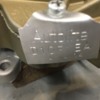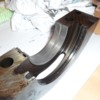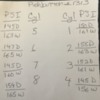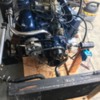I've edited this post to include more information; i.e. part numbers, prices, specifications, and explanations for choices and recommendations. I've also sorted the information, put related thoughts under the same headings, and gave those headings titles. All in the hope to make this post more understandable and therefore more useful. Its 3 times the original length.
 Prevent the Possibility of the Three “Cleveland” Failure Modes From Occurring 1. The Valve Heads “Break-Off” the Valve Stems While the Engine is Running
Prevent the Possibility of the Three “Cleveland” Failure Modes From Occurring 1. The Valve Heads “Break-Off” the Valve Stems While the Engine is Running – The factory valve heads are brittle, that's why they come apart. It has nothing to do with their 2 piece construction; the vast majority of automotive valves are assembled using 2 piece construction. Replacing the valves is the solution but the replacements don't have to be stainless steel; steel valves with stems designed for 4 groove locks will do the trick up to a rev limit of 6200 rpm. Just don't use Ford valves ... or Chinese valves. For instance Sealed Power sells the 1.710 inch 4V exhaust valves, p.n. V-1879, for $128 USD per set of 8, although they have no current listing for the 2.19 inch 4V intake valve. The smaller 2.041/1.655 valves (p.n. V-2075 and p.n. V-2030) are an even better deal at $136 USD for a complete set of 16 valves.
2. The Connecting Rod Big End Caps “Break Loose” During High Speed Operation – This happens because the threads strip out of the connecting rod nuts. The OEM rod nuts are just as failure prone as the OEM valves. Replace the OEM rod nuts with ARP p.n. 300-8381 nuts; 2 nuts per pack x 8 packs. 16 nuts cost only $32 USD. The OEM rod bolts, rated at 150,000 psi tensile strength, are fine up to 6200 rpm.
3. The Cylinder Walls Crack During High Speed (WFO) Operation – The thickness of the production block’s cylinder walls are nominally 0.160 inch thick (roughly 5/32 inch), which isn’t very thick. When pushed beyond their limits the cylinder walls crack. Those limits are about 8:1 dynamic compression, 7200 rpm, and 450 horsepower (peaking at 6500 rpm). There is nothing that can be done to strengthen the cylinder walls in street or circuit racing applications (drag racers use grout in the water jackets). Engines making up to 410 horsepower peaking at 6200 rpm or less, having no more than 8:1 dynamic compression, and rev-limited at 6200 rpm are in no danger of cracking cylinder walls as long as they are in good states of tune and their reciprocating assemblies are well balanced. The engine in your Pantera therefore requires no steps to be taken or expenditure to be made.
Limiting engines with 4V cylinder heads to 410 horsepower peaking at 6200 rpm or less can be accomplished by limiting the lift and duration of the camshafts they are equipped with. Hydraulic tappet camshafts should have no more than 0.532 inch gross lift or 230° intake duration at 0.050; solid tappet camshafts should have no more than 0.524 inch net lift or 238° intake duration at 0.050. Engines equipped with 4V cylinder heads having bigger cams (higher output) and/or being set-up for higher rev-limits should be equipped with longer 351W or 302C connecting rods and forged round skirt racing pistons custom ordered with 1.492 compression height (351W rods) or 1.418 compression height (302C rods). Longer connecting rods reduce the thrust forces bearing upon the cylinder walls and round skirt pistons spread the thrust forces bearing upon the cylinder walls over larger areas thereby decreasing the magnitude of the thrust forces bearing upon any given spot.
Resolve Four Recurrent Problems1A. FIRST PROBLEM: The Hot Oil Pressure Runs Low (below 50 psi at 2000 rpm) – If the engine is coming completely apart, use the opportunity to install tappet bore bushings; the do-it-yourself installation kit available from Wydendorf Machine costs only $400 USD. Tappet bore bushings with 0.060 inch orifices prevent excessive oil flowing to waste at the tappet bores. After the engine is equipped with tappet bore bushings a standard volume oil pump shall supply plenty of oil and the standard relief spring built into the oil pump shall be able to control hot oil pressure at the upper end of the intended design range (i.e. 60 psi to 70 psi). Additional benefits include limiting the amount of oil supplied to the valve train and isolating the motion of the tappets from the main oil passages (which impedes oil flowing to the 3 central main bearings).
1B. Any 351C equipped car that may be driven vigorously should be equipped with a racing style oil pan; this includes ALL Panteras. The G forces generated during acceleration, braking, and cornering throw the oil in the pan against the side of the sump, and away from the oil pump pick-up. The hinged doors and baffles of a racing oil pan prevent this. No matter how well you prepare the lubrication system it cannot supply oil to the engine if the suction of the oil pump is not submerged in a continuous supply of non-aerated oil. The Aviaid p.n. 155-55365 Pantera oil pan lists for $438 USD, others are available at lower pricing.
1C. However, if you decide to keep the stock oil pan there were two factory improvements to consider duplicating. (1) The Q code oil pump pick-up was a better design than the M code or H code pick-up, duplicates are available from Melling (p.n. M84-AS1), Milodon (p.n. 18635), or Sealed Power (p.n. 224-11166) . (2) A rudimentary windage tray, tack welded within the oil pan, was standard in the Q code engines; an aftermarket windage tray can be added to an M code or H code engine (Milodon p.n. 32220 or Moroso p.n. 22939).
2A. SECOND PROBLEM: The Rod Bearings are Worn or Damaged – The rod bearings are most likely in bad shape. Replace them with heavy duty CB927 tri-metal style bearings. The heavy duty bearings take the abuse of under-lubrication better than standard babbit bearings. If the journals are OEM diameter install the +0.001" style bearings and aim for 0.0022 – 0.0028 inch clearance. These “performance” clearances promote increased oil flow and reduced bearing temperatures.
2B. If the reciprocating assembly is coming out of the engine block set the rod side gap clearances at 0.018 - 0.022 inch, this also promotes increased oil flow to the rod bearings plus improved splash lubrication of the camshaft and cylinder walls.
2C. If the main bearings are coming apart replace them with heavy duty MS1010 tri metal bearings, which are FULLY GROOVED. If the journals are OEM diameter install the +0.001" style bearings here as well, shoot for 0.0025 - 0.0032 inch clearance. Fully grooved bearings supply more oil to the rod bearings. BUT with fully grooved bearings you can’t use 0W or 5W oil, use 10W30 oil; Valvoline VR1 is excellent oil for older engines. Acquiring fully grooved bearings may require using the upper shells from 2 sets of standard ½ grooved bearings (at an additional cost of $94 to $138 USD).
3A. THIRD PROBLEM: The Engine Boils-Over During Stop and Go, After a High Speed Drive, or On Mountain Roads – This is not a defect but a problem created by parts vendors. The Cleveland series engines DO NOT use the same thermostats as the SBF/Windsor series of engines. Yet over the decades (ever since the engine was new) most auto parts counters, including the parts counters at Ford and Mercury dealerships, have dispensed SBF/Windsor thermostats for Cleveland applications. Make sure the engine has the proper Robertshaw 333 thermostat installed. The thermostats sell for only $40 USD or less; if you need one it’s available from Marlin Jack or Tim Meyer. Also make sure the brass orifice is installed below the thermostat.
3B. There are 2 cooling system improvements to consider which are Pantera specific: (1) Replace the coolant pump pulley with the SACC overdrive pulley. (2) When the time arrives to replace the coolant pump consider the Flow Kooler pump which has a billet impeller intended to improve low rpm flow.
4A. FOURTH PROBLEM: The Positioning of the Crankshaft Damper’s Outer Ring Has Shifted on the Hub – This is not a defect, just a sign of old age. Nor is this a problem peculiar to the 351C, it happens to all “aging” engines equipped with unbonded crankshaft dampers. An unbonded crankshaft damper is held together by the stiction of the rubber sleeve located between the hub and ring. Any rubber sleeve which is over 20 years old has hardened and doesn’t have the stiction it used to have, plus it doesn’t dampen the crankshaft as well as it is supposed to. Replace the damper with a fully bonded damper, PowerBond PB1082SS. Available at Summit Racing for $215 USD, probably available via Tim Meyer too.
Replace the Breaker Point Ignition With a Ford Duraspark Breaker-Less Ignition• This is a must-have improvement. It reduces “misfires” which has several benefits including easier and faster starting, more low rpm torque, more horsepower at all rpm, fewer emissions and better fuel economy. The engine’s maintenance is reduced as there are no breaker points requiring periodic adjustment. Reducing misfires also makes an engine run smoother (less vibration) therefore a good electronic ignition reduces vibration and harshness. Since the forces causing vibration are destructive forces, reducing vibration indicates the magnitude of those destructive forces has also been reduced, improving an engine’s durability. The distributor calibration for most applications should be 20° centrifugal advance which begins advancing at 1000 rpm and is all in by 2800 rpm plus 18° initial advance for 38° total advance. Engines equipped with pop-up dome pistons may require more than 38° total advance to achieve full output, in those instances the distributor should be calibrated for 26° centrifugal advance which begins advancing at 1000 rpm and is all in by 3300 rpm plus 14° to 18° initial advance for 40° to 44° total advance.
Inspect and Refurbish the Short Block• Remove carbon build-up in the ring grooves.
• Since the bores look good you have the choice to re-use the rings or deglaze the cylinders and install new rings.
• Since the reciprocating assembly turns easily by hand we know the main bearing journal alignment is good and the crankshaft is straight.
• If you remove the pistons to clean the ring grooves you’ll have the opportunity to at least visually inspect the crankshaft’s rod journals.
• If the crankshaft is coming out of the block replace the rear main rope seal with a 2 piece neoprene seal.
•
If the reciprocating assembly is coming out of the engine block don't put it back in without having it spin balanced first.
Inspect and Replace the Camshaft Parts• Due to the engine’s low mileage the cam bearings can be assumed to be in decent condition.
• You should inspect the condition of the cam lobes and tappets.
• Inspect the push rods for run-out, the spec for maximum push rod run-out is 0.020 inch
• The nylon teeth on the camshaft sprocket are no doubt brittle. My recommendation would be to install a new timing set that doesn’t have nylon teeth.
Inspect and Refurbish the Heads• If you’re replacing the valves as recommended the valve seats will most likely require servicing. A good machinist will want to service the seats to reduce run-out and set the widths and diameters properly. The top cut should be 70°, the valve seat angle should be cut at 45°, and the undercut should be 30°. The seat width of the intake valves should be no less than 0.060 inch, and the seat width of the exhaust valves should be no less than 0.080 inch. Valve seat run-out should not exceed 0.0010 inch.
• If you’re installing stainless steel valves you should consider installing bronze valve guide inserts too for the sake of the valve stems. If you’re not installing stainless steel valves the guides will still need to be inspected for condition and for clearance with the stems of the new valves. You may still need to install valve guide inserts, if so install bronze inserts which have upper ends machined for spring loaded viton valve stem seals. Two possible choices are Manley’s guides p.n. 12084-8 or Sealed Power (Speed Pro) guides p.n. VG-7501R. The Manley guides are the correct length, the Sealed Power guides must be shortened to 1.625 inch below the flange.
• Mill the heads a modest 0.010 inch to compensate for the thickness of the replacement head gaskets. The compressed thickness of Fel Pro’s p.n. 8347 head gaskets is 0.010 inch thicker than the thickness of the OEM head gaskets.
Replace the parts which deteriorate with use or age, or parts which cannot be re-used. • This includes the crankshaft seal, valve stem seals, bearings (pilot bearing, throw-out bearing), gaskets, and rubber parts such as fuel system hoses, and the fuel pump (the fuel pump diaphragm is rubber).
The sum of those parts and procedures equates to a more durable, smoother running 351C without the flaws of the original engine. The mechanical compression ratio is 9.51:1 and the dynamic compression ratio is 7.30:1. The engine will operate safely on 91 octane US/Canadian pump gas (equivalent to pump gas rated 95 octane internationally). It will produce 290 horsepower peaking at 5400 rpm, and require a 6200 rpm rev limit.
.






